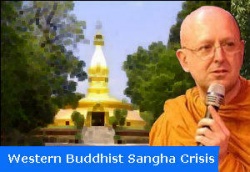Ajahn Brahm
Ajahn Brahmavamso Mahathera (known to most as Ajahn Brahm), born Peter Betts in London, United Kingdom on 7 August 1951, is a Theravada Buddhist monk.
Currently Brahm is the Abbot of Bodhinyana Monastery, in Serpentine, Western Australia, the Spiritual Director of the Buddhist Society of Western Australia, Spiritual Adviser to the Buddhist Society of Victoria, Spiritual Adviser to the Buddhist Society of South Australia, Spiritual Patron of the Buddhist Fellowship in Singapore, and Spiritual Patron of the Bodhikusuma Centre in Sydney.
Early life
Peter Betts came from a working-class background and went to Latymer Upper School.
He won a scholarship to study Theoretical physics at Cambridge University in the late 1960s.
After graduating from Cambridge he taught in high school for one year before traveling to Thailand to become a monk and train with the Ajahn Chah Bodhinyana Mahathera. Brahm was ordained in Bangkok at the age of twenty-three by the Abbot of Wat Saket.
He subsequently spent nine years studying and training in the forest meditation tradition under Ajahn Chah.
Bodhinyana Monastery
Brahm was invited to Perth, Australia by the Buddhist Society of Western Australia to assist Ajahn Jagaro in teaching duties. Initially they both lived in an old house in the suburb of North
Perth, but in late 1983 purchased 97 acres (393,000 m²) of rural and forested land in the hills of Serpentine south of Perth.
The land was to become Bodhinyana Monastery (named after their teacher, Ajahn Chah Bodhinyana).
Bodhinyana was to become the first dedicated Buddhist monastery in the Southern Hemisphere and is today the largest community of Buddhist monks in Australia.
Initially there were no buildings on the land, and as there were only a few Buddhists in Perth at this time, and little funding, the monks themselves began building to save money. Brahm learnt plumbing and bricklaying and built many of the current buildings himself.
In 1994, Jagaro took a sabbatical leave from Western Australia and disrobed a year later.
Left in charge, Brahm took on the role and was soon being invited to provide his teachings in other parts of Australia and South-East Asia.
He has been a speaker at the International Buddhist Summit in Phnom Penh in 2002, and at three Global Conferences on Buddhism.
He also dedicates time and attention to the sick and dying, those in prison or ill with cancer, people wanting to learn to meditate, and also to his Sangha of monks at Bodhinyana.
Brahm has also been influential in establishing Dhammasara Nuns' Monastery at Gidgegannup in the hills north-east of Perth to be a wholly independent monastery, which jointly administered by Venerable Nirodha and Venerable Hasapanna.
Bhikkhuni ordination
On 22 October 2009 Brahm facilitated an ordination ceremony for bhikkhunis where four female Buddhists, Venerable Ajahn Vayama, and Venerables Nirodha, Seri and Hasapanna, were ordained into the Western Theravada bhikkhuni sangha.
The ordination ceremony took place at Ajahn Brahm's Bodhinyana Monastery at Serpentine (near Perth, WA), Australia.
There is no consensus in the wider tradition that bhikkhuni ordinations could be valid, having last been performed in Theravada communities over 1,000 years ago, though the matter has been under active discussion for some time.
Brahm claims that there is no valid historical basis for denying ordination to bhikkunis.
But having investigated and studied, I’ve found out that ::many of the obstacles we thought were there aren’t there at all.
Someone like Bhikkhu Bodhi [a ::respected Theravada scholar-monk has researched the Pali Vinaya and his paper is one of the ::
most eloquent I’ve seen – fair, balanced, comes out on the side of “It’s possible, why don’t we ::do this?”
For his actions of 22 October 2009, on 1 November 2009, at a meeting of senior members of the Thai monastic sangha, held at Wat Pah Pong, Ubon Ratchathani, Thailand, Brahm was removed from the Ajahn Chah Forest Sangha lineage and is no longer associated with the main monastery in Thailand,
Wat Pah Pong, nor with any of the other Western Forest Sangha branch monasteries of the Ajahn Chah tradition.
Achievements
Whilst still a junior monk, Brahm was asked to undertake the compilation of an English-language guide to the Buddhist monastic code - the vinaya - which later became the basis for monastic discipline in many Theravadan monasteries in Western countries.
Currently Brahm is the Abbot of Bodhinyana Monastery, in Serpentine, Western Australia, the Spiritual Director of the Buddhist Society of Western Australia, Spiritual Adviser to the Buddhist Society of Victoria,
Spiritual Adviser to the Buddhist Society of South Australia, Spiritual Patron of the Buddhist Fellowship in Singapore, Spiritual Patron of the Bodhikusuma Centre in Sydney.
In October 2004, Brahm was awarded the John Curtin Medal for his vision, leadership and service to the Australian community by Curtin University.
He is currently working with monks and nuns of all Buddhist traditions in the Australian Sangha Association.
Publications
- Opening the Door of Your Heart:
And Other Buddhist Tales of Happiness.
Also published as Who Ordered This Truckload of Dung?: Inspiring Stories for Welcoming Life's Difficulties. (2005). Wisdom Publications.
Also published in Indonesia as Si Cacing dan Kotoran Kesayangannya in 3 volumes, vol.1 (2010), vol.2 (2011), vol.3 (2012) ISBN 0-86171-278-1
- Mindfulness, Bliss, and Beyond: A Meditator's Handbook. (2006). Wisdom Publications. ISBN 0-86171-275-7
- The Art of Disappearing: Buddha's Path to Lasting Joy. (2011). Wisdom Publications. ISBN 0-86171-668-X

